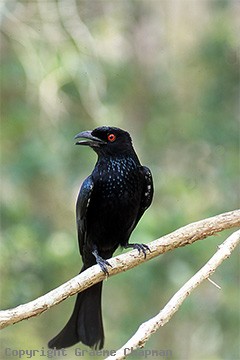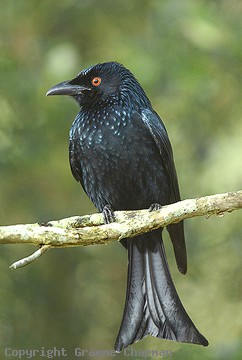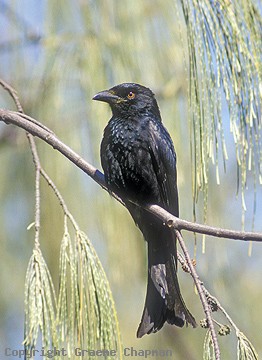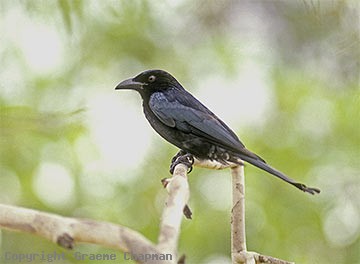Australian Birds
Spangled Drongo
Dicrurus bracteatus
(Viewing 4 of 6 photos)
|
Drongos of various sorts range from Africa, India and the tropics through to New Guinea and the islands and as far as Australia where the Spangled Drongo is our only representative. Mainly preferring more humid coastal habitats, drongos range all across the north where they are residents, and down the east coast where most of them are migratory. Breeding birds occur as far south as Coffs Harbour and a few nomadic individuals sometimes reach the Victorian border, but the odd vagrant has been seen as far as Tasmania, Their distinctive forked tail, a character shared with a few other drongos, is a key field mark.
Extremely acrobatic in flight, they catch much of their insect food on the wing but they are quite omnivorous and also eat fruit, nectar (they have a brush-tipped tongue) and occasionally small birds. At Beerwah in Qld they used to visit our bird feeder and would snatch morsels of mince or cheese thrown to them, on the wing.
In such situations where there is competition for food, they have an almost comical looking aggressive display where they "raise their eyebrows" (see pic.673212D)
Perhaps their most fascinating display is their "parachute flight". Usually carried out not far from the nest, a bird flies upward calling, the with wings held almost vertically and tail arched over the back and head looking down it parachutes slowly down to within a few metres of the ground before flying off normally.
Spangled Drongos nest as pairs, in territories sometimes quite close together (c 50 m apart), the same territories re-occupied year after year.Young birds stay with their parents for about a month after fledging.They then form small flocks and wander in search of food before migrating. Flocks of 30 or so are normal but the occasional flock of 100 has been seen near Rockhampton and on one occasion west of Grafton I chanced upon a flock of about 200 birds which as far I could see, was a peer group of young birds, all with brown eyes.
|









